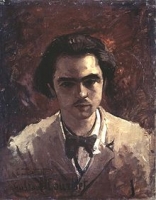阅读魏尔伦 Paul-Marie Veriaine在诗海的作品!!! | |||
魏尔伦生于法国东部城镇梅斯。他的父亲是一格法国军官,母亲则是一个虔诚、富有的女人。他7岁时,举家前往巴黎。魏尔伦早年学过法律,做过保险公司的职员,他很快就对这份工作感到厌烦,并开始沉溺于酒精。
1870年,尽管魏尔伦有同性恋的倾向,但他还是娶了一个16岁的姑娘,并育有一子。他一边活跃在上流社会的沙龙,同时也热爱波希米亚群体。
魏尔伦着迷于波德莱尔的诗歌,1866年,他出版了他的第一本诗集。
他早期的诗风讽刺而沉思,类似于当时的印象主义。他的诗歌是人生片段的缩影:初吻、贝壳、街头即景。
1871年,革命在巴黎爆发,魏尔伦支持巴黎公社,在激进的临时政府中做过审查员。革命失败后,他不再对政治感兴趣,重新沉湎于杜松子酒和苦艾酒。1871年,魏尔伦发现了兰波的诗歌天赋,并不顾舆论,疯狂地爱上他。他们在伦敦和布鲁塞尔过来人两年的同居生活,在一系列争执后,魏尔伦酒后开枪打伤了兰波的手腕,因此入狱两年。
1881年,魏尔伦出版了诗集《智慧》,销量好于他以前的作品。
晚年,他陷入了更暗淡的主题,整天在巴黎的咖啡馆狂饮苦艾酒,混迹于两个妓女之间,挥霍他的版税。
1894年,他出版了名为《死后书》的诗集,他的诗歌是自指的,一个豪饮苦艾酒的诗人的形象,成为诗歌的主题。
1896年,他死于一个妓女的家中。
Early life
Born in Metz, he was educated at the lycée Bonaparte (now the lycée Condorcet),[1] in Paris and then took up a post in the civil service. He began writing poetry at an early age, and was initially influenced by the Parnassien movement and its leader, Charles Leconte de Lisle. Verlaine's first published collection, Poèmes saturniens (1866),[2] though adversely commented upon by Sainte-Beuve, established him as a poet of promise and originality.
Marriage and military service
Verlaine's private life spills over into his work, beginning with his love for Mathilde Mauté. Mauté became Verlaine's wife in 1870. At the proclamation of the Third Republic in the same year, Verlaine joined the 160th battalion of the Garde nationale, turning Communard on March 18, 1871.
He became head of the press bureau of the Central Committee of the Paris Commune. Verlaine escaped the deadly street fighting known as the Bloody Week, or Semaine Sanglante, and went into hiding in the Pas-de-Calais.
Imprisonment
Verlaine returned to Paris in August 1871, and, in September, he received the first letter from the poet Arthur Rimbaud. By 1872, he had lost interest in Mathilde, and effectively abandoned her and their son, preferring the company of his new lover.[2] Rimbaud and Verlaine's stormy love affair took them to London in 1872. In July 1873 in a drunken, jealous rage, he fired two shots with a pistol at Rimbaud, wounding his left wrist, though not seriously injuring the poet. As an indirect result of this incident, Verlaine was arrested and imprisoned at Mons, where he underwent a conversion to Roman Catholicism, which again influenced his work and provoked Rimbaud's sharp criticism. Romances sans paroles was the poetic outcome of this period.
Following his release from prison, Verlaine again traveled to England, where he worked for some years as a teacher and produced another successful collection, Sagesse. He returned to France in 1877 and, while teaching English at a school in Rethel, became infatuated with one of his pupils, Lucien Létinois, who inspired Verlaine to write further poems. Verlaine was devastated when the boy died of typhus in 1883.
Final years
Verlaine's last years witnessed a descent into drug addiction, alcoholism, and poverty. He lived in slums and public hospitals, and spent his days drinking absinthe in Paris cafes. Fortunately, the French people's love of the arts was able to resurrect support and bring in an income for Verlaine: his early poetry was rediscovered, his lifestyle and strange behavior in front of crowds attracted admiration, and in 1894 he was elected France's "Prince of Poets" by his peers. His poetry was admired and recognized as ground-breaking, serving as a source of inspiration to famous composers, such as Gabriel Fauré, who set many of his poems to music, including La bonne chanson, and Claude Debussy, who set five of the Fêtes galantes poems to music, forming part of the mélodie collection known as the Recueil Vasnier.[3]
Paul Verlaine died in Paris at the age of 51 on January 8, 1896., and was buried in the Cimetière des Batignolles.
Style
Verlaine in a caféMuch of the French poetry produced during the fin de siècle was characterized as "decadent" for its lurid content or moral vision. In a similar vein, Verlaine used the expression poète maudit ("accursed poet") in 1884 to refer to a number of poets like Stéphane Mallarmé and Arthur Rimbaud who had fought against poetic conventions and suffered social rebuke or were ignored by the critics. But with the publication of Jean Moréas' Symbolist Manifesto in 1886, it was the term symbolism which was most often applied to the new literary environment. Along with Verlaine, Mallarmé, Rimbaud, Paul Valéry, Albert Samain and many others began to be referred to as "Symbolists". These poets would often share themes that parallel Schopenhauer's aesthetics and notions of will, fatality and unconscious forces, and used themes of sex (such as prostitutes), the city, irrational phenomena (delirium, dreams, narcotics, alcohol), and sometimes a vaguely medieval setting.
In poetry, the symbolist procedure - as typified by Verlaine - was to use subtle suggestion instead of precise statement (rhetoric was banned) and to evoke moods and feelings through the magic of words and repeated sounds and the cadence of verse (musicality) and metrical innovation.
Portrayals
Rimbaud as drawn by VerlaineNumerous artists painted Verlaine's portrait. Among the most illustrious were Henri Fantin-Latour, Antonio de la Gándara, Eugène Carrière, Frédéric Cazalis, and Théophile-Alexandre Steinlen.
The time Verlaine and Rimbaud spent together was the subject of the 1995 film Total Eclipse, directed by Agnieszka Holland and with a screenplay by Christopher Hampton, based on his play. Verlaine was portrayed by David Thewlis.
Works
Verlaine's Complete Works are available in critical editions from the Bibliothèque de la Pléiade.
Poèmes saturniens (1866)
Les Amies (1867)
Fêtes galantes (1869)
La Bonne chanson (1870)
Romances sans paroles (1874)
Sagesse (1880)
Les Poètes maudits (1884)
Jadis et naguère (1884)
Amour (1888)
Parallèlement (1889)
Dédicaces (1890)
Femmes (1890)
Hombres (1891)
Bonheur (1891)
Mes hôpitaux (1891)
Chansons pour elle (1891)
Liturgies intimes (1892)
Mes prisons (1893)
Élégies (1893)
Odes en son honneur (1893)
Dans les limbes (1894)
Épigrammes (1894)
Confessions (1895)
References
^ Article in Wikipedia français
^ a b Paul Verlaine. Litweb.net. Retrieved on 2007-07-18.
^ Rolf, Marie. Page 7 of liner notes to Forgotten Songs by Claude Debussy, with Dawn Upshaw and James Levine, Sony SK 67190.
Paul Verlaine, Correspondance générale: [Vol.] I, 1857-1885 (edited and annotated by Michael Pakenham). Paris: Fayard, 2005. 16 x 24 cm. 1,122 pages. ISBN 2-213-61950-6

